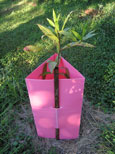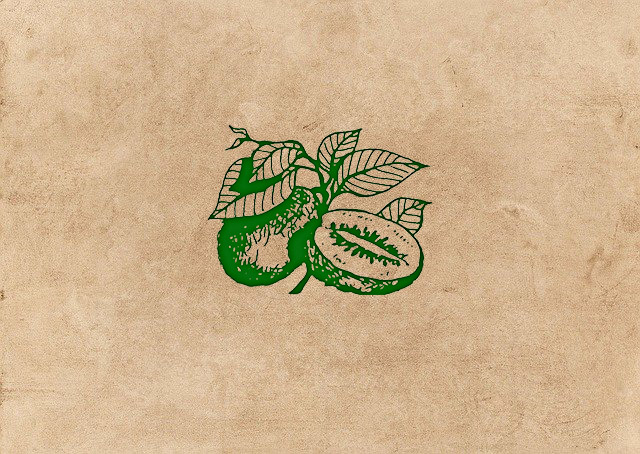Care and Planting of Fruit Trees
Guide to Care and Planting of Fruit Trees
A. CARE OF PLANTS BEFORE PLANTING
Place trees in a position that has direct sunlight for at least half the day and protection from strong winds. Water thoroughly.
B. SITE PREPARATION
If possible, site preparation should begin 6 months prior to planting. The following points should be considered:
1. Fence off the proposed Orchard
2. For poor soil (i.e. less than 1 metre of top soil and not of a sandy nature) Deep Ripping is advised to improve drainage (rip to a depth of at least 45cm). The last Ripping should be down the slope, as deep as possible to help sub-soil drainage. Erosion control will prevent washing out of furrows.
Diversion Drains at top of orchard site are recommended.
3. If soil is too shallow, mounding of tree rows will improve drainage as well as increase depth of topsoil.
4. Green Manure Crops improve the organic matter content of soil and can be ploughed in approx 1 month prior to planting.
5. Wind break trees are very important and should be planted before fruit trees. Windbreaks should be planted along south, west and east sides of orchard, leaving the north side open.
C. PLANTING THE TREES
Trees can be planted out at most times of the year, provided the following points are followed:
1. Planting hole - if soil is not well drained it is advised to make a circular mound 1.5 metres across and 20-30cm high. This can be achieved by bringing outside loamy soil to the planting site or alternatively mound existing soil. Do Not plant trees in holes in heavy clay soils as the hole will act like a sump and hold excess water.
2. Watering - trees should be watered thoroughly several hours before planting to moisten the root ball. Planting trees out with the root ball dry or partially dry will result in roots being damaged. The site should also be thoroughly watered the day before planting.
3. Planting - make a hole in the soil or mound twice the width of the pot and the same depth as the pot. Remove the tree from the pot and lightly tease roots down side of the root ball and loosen any matted roots at base of root balls. Fill in soil around roots, making sure not to plant root ball any more than 2cm lower than it was in the container. Trees will suffer if planted too deep. Soil should be firmed down well after planting. At least 20 litres of water should be applied to each tree to settle in soil around roots. A saucer shaped depression 50cm in diameter will help hold water when watering in.
Applying a Slow Release Fertilizer at planting will help the young trees off to a good start. This can be applied by
scratching into the surface around the young tree. One of the following or a mixture can be applied. Blood & Bone, Dynamic Lifter, Osmocote, Nutricote or Nitrophoska
If mixture is applied, reduce quantities of each proportionally. If soil is acid also apply dolomite or lime.
5. Staking - trees are better off not staked, but if needed, two tomato stakes on each side of tree (30cm from tree) will support tree by using old pantyhose or similar material.
 6. Mulching the trees with old straw, hay etc, will stop soil from drying out, heating up, stops weeds from germinating and also adds valuable organic matter. Do Not apply mulch against trunk of tree as Collar Rots may occur. Trees that are susceptible to frost damage are better off without mulch during the winter months, the reason being that bare soil kept moist will absorb heat during the day and radiate this heat at night reducing severity of frost.
6. Mulching the trees with old straw, hay etc, will stop soil from drying out, heating up, stops weeds from germinating and also adds valuable organic matter. Do Not apply mulch against trunk of tree as Collar Rots may occur. Trees that are susceptible to frost damage are better off without mulch during the winter months, the reason being that bare soil kept moist will absorb heat during the day and radiate this heat at night reducing severity of frost.
7. Grow Bags placed over young trees will give protection during the winter months and allow an early growth in spring. They also protect trees from wildlife.
D. CARE OF TREES AFTER PLANTING
1. Weed Control - Most important if trees are to grow quickly. Weeds shouldn't be allowed to grow within one metre of the tree for the first year. After this keep area out to the drip line (i.e. width of foliage) free of weeds. Mulch will control most weeds.
2. Fertilising- trees will respond to feeding. How often and how much fertiliser to apply will depend on soil type and the trees requirements (refer to DPI 'Ag Facts' for specific requirements). If you do not want to use chemical fertilisers consider applying one or a combination of organic fertilizers (e.g. poultry manure, rock phosphate, blood and bone etc).
3. Mulching - the use of Organic Mulch is very important for healthy trees. Any organic material can be used, e.g. Lawn clippings, weeds, straw etc. Hay, especially soybean stubble or lucerne hay is excellent. As the mulches break down they will feed the tree with valuable nutrients.
4. Watering-Setting up a permanent under-tree sprinkler irrigation system is well worth considering. Frequency and amount of watering will depend on a number of factors, but a good watering once a week is a good guideline.
5.Desuckering - remove any shoots coming from below graft on grafted trees while trees are young. The removal promotes growth of grafted variety only.
6. Pruning-Fruit trees need pruning to produce good crops of fruit as well as keep trees to a manageable size. Most deciduous fruit trees in particular need annual pruning. Pruning also invigorates the tree and encourages new fruiting wood for the following year














